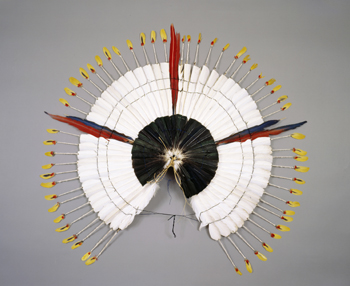![[Metroactive Arts]](/arts/gifs/art468.gif)
[ Arts Index | Silicon Valley | Metroactive Home | Archives ]

Topping Off: An elaborate dorasal headdress is worn by young Karajá men when they are deemed worthy of becoming adults. River Run 'Vanishing Worlds' show at Cantor preserves ritual artifacts of endangered Amazonians By Michael S. Gant PITY THE PEOPLES of the Amazon basin. Five hundred years ago, the conquistadors showed up and decimated them looking for gold and treasure; then the missionaries went to work. To add insult to injury, this month White Stripes guitarist Jack White reportedly married supermodel Karen Elson in a ceremony in the Brazilian rainforest presided over by a shaman in a canoe. Pop-cult appropriation may be the worst blow of all to an indigenous population attempting to preserve its traditional way of life. Just how rich (and threatened) that way of life really is can be seen in dazzling profusion at "Vanishing Worlds: Art and Ritual in Amazonia," now on display at Stanford's Cantor Arts Center. The exhibit, organized by the Houston Museum of Natural Science, features scores of ceremonial artifacts from a variety of Amazon tribes. The objects range from full-body straw shaman outfits to delicate arm jewelry fashioned from feathers; from pectoral shields decorated with the stuffed heads of toucans to a bullroarer painted with abstract patterns that looks like nothing so much as a skateboard without wheels. Long cascading strings of iridescent beetle wings form glistening green earrings. Most impressive are the headdresses used in various initiation rituals. The large dorsal headdresses of the Kayapó of Central Brazil are shaped like horse collars and fashioned from hundreds of intricately and symmetrically layered parrot feathers braced by an oval loop of palm frond. In one example, an arc of brilliant yellow feathers glows like a solar flare, broken at the top by a fan of six longer, red feathers. One Karajá headdress takes the form of a close-fitting conical cap tiled over with small feather pieces that rises, chimneylike, to a circle of extenuated tail feathers. Other head decorations from the Karajá tribe fan out from a central disk with radiating woven strings that end in multicolor feather tufts. The aesthetic sensibility in evidence in the choice and design of the materials is every bit as exceptional as the woeful story of the tribe is typical. After an initial era of peaceful trade with the Europeans, a period of slave raiding and open warfare was followed by the ravages of introduced epidemics; today, their population numbers approximately 3,000. Although heavily deracinated by their careful placement against uniform blue backgrounds in acrylic cases under low track lighting, the objects still retain some of their magical import. A grouping of woven costumes used by the Ticuna in initiation rites looms ominously on a raised platform. A crocodile effigy is somehow more chilling standing upright rather than lying flat and slithering. A ferociously masked demon comes with outsized genitals and long, clawed fingers, a la Freddy Krueger. A bit more benign but no less mysterious is a Kuikuru fiber and burlap mask in the (suggestive, not literal) shape of a giant river otter, with a flat painted face with a gnomic expression. Of course, appreciating these extraordinary creations and understanding them are two very different things in a museum setting. Removed from the bodies of the shamans and initiates who inhabited them, the headdresses, masks and waist belts inevitably become objectified rather than animated. They can even look like examples of high couture. Indeed, a Yawalapiti fiber and Jaguar-pelt headdress could easily be Bob Dylan's "brand-new leopard-skin pill-box hat."
Vanishing Worlds: Art and Ritual in Amazonia runs through Aug. 21 at the Cantor Arts Center at Stanford University. The museum is open Wednesday-Sunday, 11am-5pm (till 8pm Thursday). (650.723.4177)
Send a letter to the editor about this story to letters@metronews.com. [ Silicon Valley | Metroactive Home | Archives ]
|
From the June 8-14, 2005 issue of Metro, Silicon Valley's Weekly Newspaper.
Copyright © Metro Publishing Inc. Metroactive is affiliated with the Boulevards Network.
For more information about the San Jose/Silicon Valley area, visit sanjose.com.